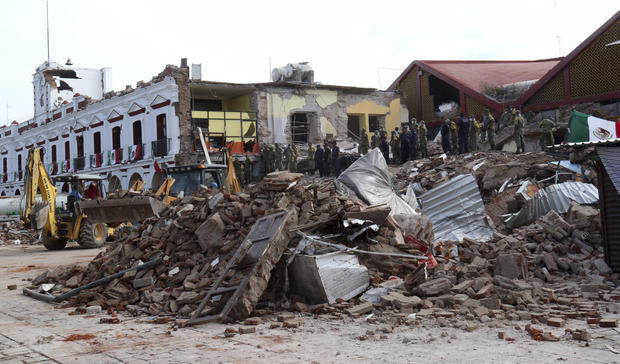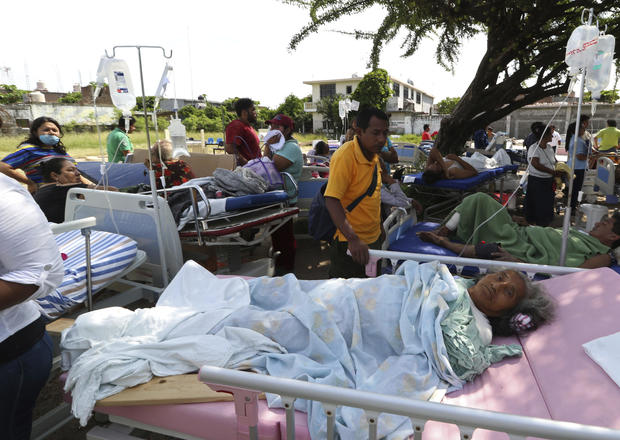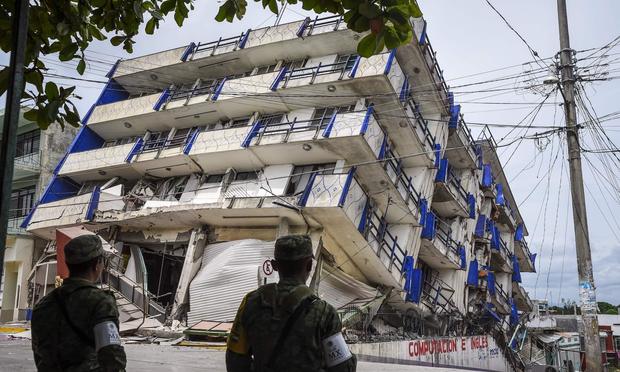墨西哥強震「房屋如口香糖般搖晃」

已造成60人喪生
墨西哥當地7日深夜發生強震,離震央1000公里的首都墨西哥市都能感受強烈搖晃。強震目前已知造成60人喪生,可能持續攀升。
中國駐墨西哥大使館表示,目前尚未收到中國公民在地震中傷亡的報告;中華民國駐墨西哥代表廖世傑也表示,鄰近震央的地區沒有台僑,目前在墨台僑與台商都平安。
美國地質調查所測得芮氏規模8.1的主震,墨西哥國家地震研究所原本測得主震為芮氏規模8.2,稍後上修至8.4。
墨西哥總統潘尼亞尼托指出,這次地震為百年以來墨國遭遇最強烈地震。瓦哈卡州有45人死亡、奇亞帕斯10人、塔巴斯戈3人喪生。奇亞帕斯居民形容地震時,「房屋如口香糖般搖晃」。
美聯社報導,這次強震受創最嚴重的地方是胡契坦市,市政廳有一半遭震垮,街道遍布坍塌房屋的瓦礫碎片。其他地區也不斷傳出地震災情,全墨西哥有數百萬房屋倒塌或損壞,180萬人無電可用,11個州宣布8日因安全顧慮停課。
太平洋海嘯警報中心表示,海港薩利納克魯斯出現至少1公尺高海嘯,所幸沒有造成損失傷亡。
美國地質調查局表示,墨西哥這次地震震央位於太平洋板塊東部俯衝帶交匯處。震央鄰近俯衝帶的地震通常都是歷史著名的強震,例如2011年的日本福島大地震,2004年的蘇門答臘地震。
7日的強震發生後,大西洋颶風卡狄亞亦將緊接著來襲,已增強為二級並有可能升為三級的卡狄亞,預計於當地時間9日清晨在墨西哥登陸。
Mexico earthquake kills dozens, topples hundreds of buildings -- live updates
Last Updated Sep 8, 2017 4:42 PM EDT
MEXICO CITY -- Dozens were killed after one of Mexico's strongest earthquakes struck off the country's southern coast, toppling hundreds of buildings, triggering tsunami evacuations and sending panicked people fleeing into the streets in the middle of the night.
Mexico's civil defense chief, Luis Felipe Puente, says the death toll has risen to 58.
The quake hit minutes before midnight Thursday and was strong enough to cause buildings to sway violently in the capital city more than 650 miles away. As beds banged against walls, people still wearing pajamas ran out of their homes and gathered in frightened groups.
CBS Dallas/Fort Worth reporter Jeff Paul was in Puerto Escondido when the quake hit. He said he watched his house sway and the motion of the earth caused waves in a nearby swimming pool.
"It was one of those experiences where it kind of left you shaking there for a while," he said.
CBS NEWS
Rodrigo Soberanes, who lives near San Cristobal de las Casas in Chiapas, the state nearest the epicenter, said his house "moved like chewing gum."
The furious shaking created a second national emergency for Mexican agencies already bracing for Hurricane Katia on the other side of the country. The system was expected to strike the Gulf coast in the state of Veracruz early Saturday as a Category 2 storm that could bring life-threatening floods.
Puente confirmed the deaths of 45 people in the southern state of Oaxaca. Another 10 people died in Chiapas and three more in the Gulf coast state of Tabasco.
The worst-hit city appeared to be Juchitan, on the narrow waist of Oaxaca known as the Isthmus. About half of the city hall collapsed in a pile of rubble and streets were littered with the debris of ruined houses. Local officials said at least 17 of the 35 dead were in Juchitan.
Mexico's capital escaped major damage, but the quake terrified sleeping residents, many of whom still remember the catastrophic 1985 earthquake that killed thousands and devastated large parts of the city.
Families were jerked awake by the grating howl of the capital's seismic alarm. Some shouted as they dashed out of rocking apartment buildings. Even the iconic Angel of Independence Monument swayed as the quake's waves rolled through the city's soft soil.
Soldiers remove debris from a partly collapsed municipal building after an earthquake in Juchitan, Oaxaca state, Mexico, Friday, Sept. 8, 2017.
LUIS ALBERTO CRUZ / AP
Elsewhere, the extent of destruction was still emerging. Hundreds of buildings collapsed or were damaged, power was cut at least briefly to more than 1.8 million people and authorities closed schools Friday in at least 11 states to check them for safety.
The earthquake hit off of Chiapas's Pacific coast, near the Guatemalan border with a magnitude of 8.1 -equal to Mexico's strongest of the past century. It was slightly stronger than the 1985 quake, the U.S. Geological Survey said.
The epicenter was in a seismic hotspot in the Pacific where one tectonic plate dives under another. These subduction zones are responsible for producing some of the biggest quakes in history, including the 2011 Fukushima disaster and the 2004 Sumatra quake that spawned a deadly tsunami.
Oaxaca Gov. Alejandro Murat told local news media that at least 23 people had died in his coastal state. Officials said at least 10 died in Chiapas and two others in the Gulf coast state of Tabasco.
The quake struck at 11:49 p.m. Thursday local time, and its epicenter was 102 miles west of Tapachula in Chiapas. It had a depth of 43.3 miles, the USGS said. Dozens of strong aftershocks rattled the region in the following hours.
Evacuated patients lie on their hospital beds shaded by a tree, in the aftermath of a massive earthquake, in Juchitan, Oaxaca state, Mexico, Friday, Sept. 8, 2017.
LUIS ALBERTO CRUZ / AP
Chiapas Gov. Manuel Velasco said that three people were killed in San Cristobal, including two women who died when a house and a wall collapsed. "There is damage to hospitals that have lost energy," he said. "Homes, schools and hospitals have been damaged."
Tabasco Gov. Arturo Nunez said one child died when a wall collapsed, and an infant died in a children's hospital when the facility lost electricity, cutting off the ventilator.
The Pacific Tsunami Warning Center said waves of 3.3 feet above the tide level were measured off Salina Cruz, Mexico. Smaller tsunami waves were observed on the coast or measured by ocean gauges elsewhere. The center's forecast said Ecuador, El Salvador and Guatemala could see waves of a meter or less. No threat was posed to Hawaii or the western and South Pacific.
Authorities briefly evacuated a few residents of coastal Tonala and Puerto Madero because of the warning.
In neighboring Guatemala, President Jimmy Morales appeared on national television to call for calm while emergency crews surveyed damage. Officials later said only four people had been injured and several dozen homes damaged.
The quake occurred near the point of collision between three tectonic plates, the Cocos, the Caribbean and the North American.
Soldiers stand guard a few metres away from the Sensacion hotel which collapsed with the powerful earthquake that struck Mexico overnight, in Matias Romero, Oaxaca State, on September 8, 2017.
VICTORIA RAZO/AFP/GETTY
The area has seen at least six other quakes of magnitude 7.0 or greater since 1900. Three of those occurred within a nerve-wracking nine-month span in 1902-1903, according to Mexico's National Seismological Service.
Scientists were still reviewing data, but a preliminary analysis indicated the quake was triggered by the sudden breaking or bending of the Cocos plate, which dives beneath Mexico. That type of process does not happen often in subduction zones. Usually, big quakes in subduction zones occur along the boundary between the sinking slab and the overriding crust.
"It's unusual, but it's not unheard of," said seismologist Susan Hough of the USGS, describing how stresses on the seafloor can produce big earthquakes.
The new quake matched the force of a magnitude 8.1 quake that hit the country on June 3, 1932, roughly 300 miles west of Mexico City.
A study by the seismological service concluded that that quake killed about 400 people and caused severe damage around the port of Manzanillo. A powerful aftershock that hit 19 days later caused a tsunami that devastated 15 miles of coastline, killing 75 people.




Comments
Post a Comment